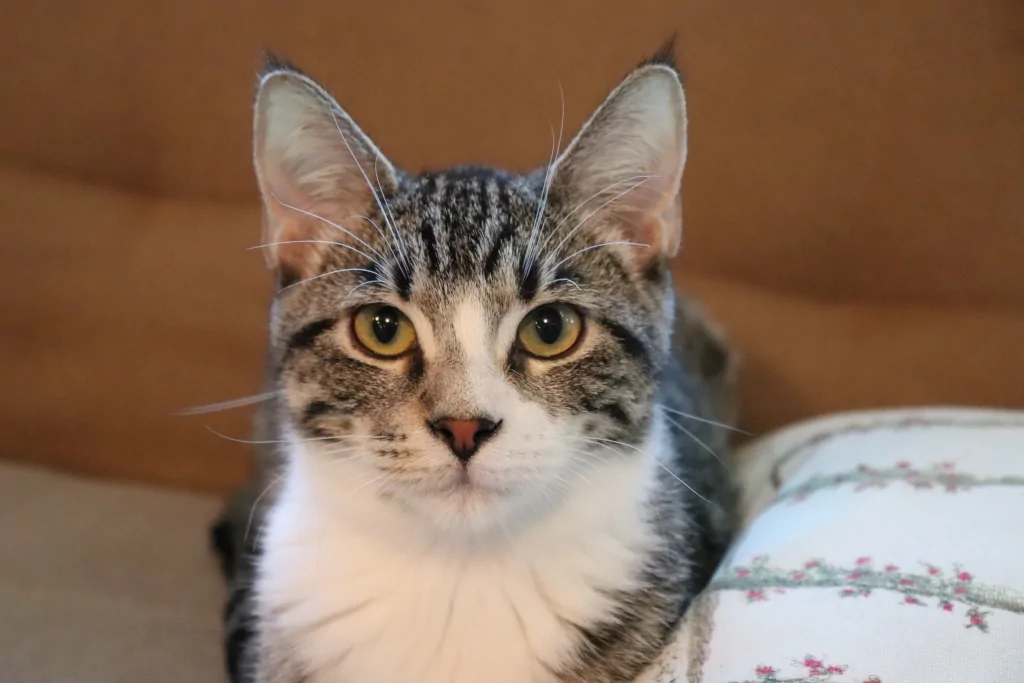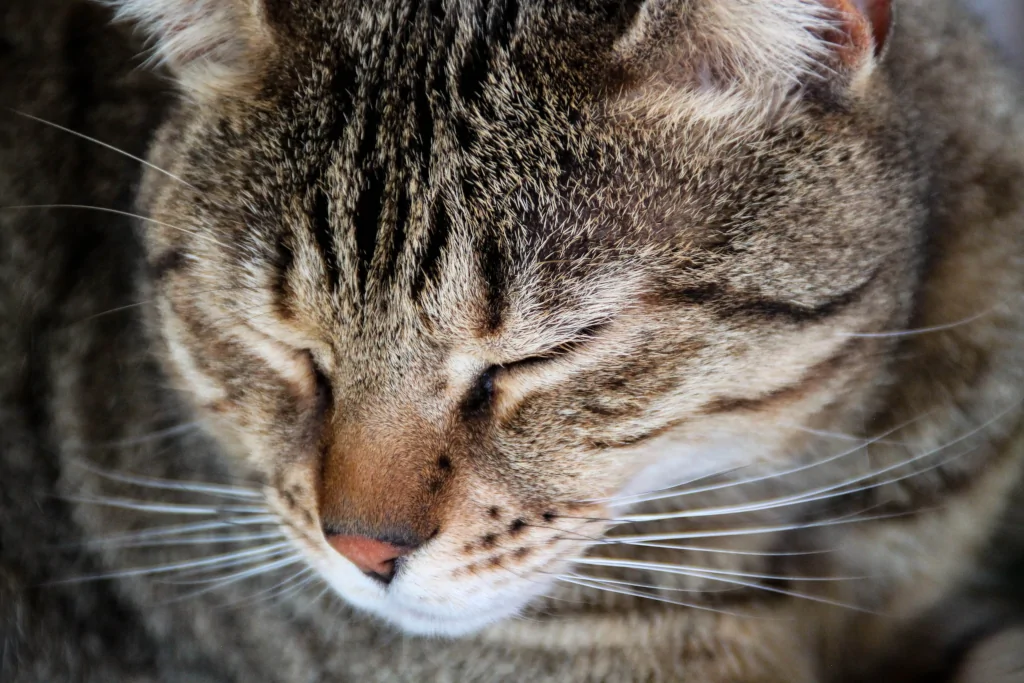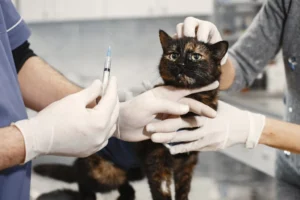Our feline companions can sometimes be quite enigmatic.
Decoding their mysterious body language can feel like a complex puzzle, especially when it comes to understanding their tail, ear, and eye movements.
Grasping these subtle cues can help us connect with our cats on a deeper level, prevent miscommunications, and ultimately, ensure a happier coexistence.
So, let’s dive into the world of feline communication and discover how to decipher these intriguing signals.

Why Should You Learn These Signals?
By learning to interpret your cat’s tail, ear, and eye movements, you’ll be able to identify your cat’s emotions and needs, leading to a more harmonious relationship.
This knowledge also empowers you to respond appropriately to their behavior, reducing the chances of accidentally causing stress or fear.
In addition, recognizing signs of distress or discomfort can help you address potential health issues early on.
So, sharpen your observation skills and get ready to unlock the secrets of feline body language.
The Expressive Tail
A cat’s tail can reveal a lot about their mood and intentions. Let’s explore some common tail movements and their meanings, so you can better understand your feline friend.

What Does a Straight-up Tail Mean?
When your cat holds their tail straight up, they’re usually feeling content and relaxed. This vertical tail position is often accompanied by a slight curl at the tip, indicating a friendly greeting.
Example:
The Meaning Behind a Puffed-up Tail
A puffed-up tail signals that your cat is feeling threatened or frightened. This defensive posture is their way of making themselves appear larger to ward off any perceived dangers.
If you see your cat’s tail suddenly puff up like a bottle brush, you should try to identify the source of their fear and help them feel safe again. Providing some enrichment can help them feel relaxed and boost their happiness.
Understanding Tail Flicks and Wags
Unlike dogs, when cats wag or flick their tail, it’s not a sign of happiness.
Instead, these movements often indicate frustration or agitation. A gentle tail flick may signal mild annoyance, while more vigorous wags can indicate increasing irritation.
If your cat’s tail starts flicking during playtime, it might be a good idea to give them some space to cool off.
The Language of Ears
Just like their tails, a cat’s ears can convey a wealth of information about their mood and feelings. Let’s delve into the world of feline ear language to better understand your kitty’s emotions and thoughts.
Forward-Facing Ears: Relaxed and Attentive
When your cat’s ears are pointing forward, it’s a sign that they are relaxed and attentive. This ear position indicates that your feline companion is interested in their surroundings and open to engaging with you.
Example:
Sideways or Flattened Ears: Anxious or Defensive
If your cat’s ears are turned sideways or flattened against their head, it signals that they feel anxious, defensive, or even scared.
This is their way of protecting their ears from potential harm. When you see your cat in this state, it’s essential to recognize their vulnerability and proceed with caution to avoid escalating the situation.
Rotating Ears: Assessing the Environment
Cats are curious creatures, and their ears play a crucial role in assessing their environment. When your cat’s ears rotate independently, it means they’re trying to pinpoint the source of a sound or detect any potential threats or opportunities.
Occasionally, my cat Smokey hears a strange noise outside, and his ears rotate like little radar dishes as he tries to determine what is happening. It usually turns out to be just a gust of wind, or some typical noise, but his keen senses are often on high alert.
Eye Signals in Cats
Your cat’s eyes can be a window into their soul, revealing their emotions and thoughts. Here, we’ll explore common feline eye signals and their meanings, enabling you to better understand and connect with your kitty.
Dilated Pupils: Excitement or Fear
When your cat’s pupils are dilated, it can indicate excitement or fear. It’s essential to consider the context of the situation to determine which emotion your cat is experiencing.
Example:
Constricted Pupils: Contentment or Aggression
Constricted pupils can signify contentment or aggression in your cat.
Again, context is key. If your cat is resting peacefully with constricted pupils, they are likely feeling content. However, if their body language is tense or their ears are flattened, it could be a sign of aggression.
When I accidentally stepped on Smokey’s tail, his pupils constricted, accompanied by a low growl, which indicated his displeasure. I was really sorry, and, luckily, he forgave me ;).
The Slow Blink: A Sign of Trust

The slow blink is a well-known feline signal of trust and affection.
When your cat looks at you and slowly blinks, they’re communicating that they feel safe and comfortable in your presence It’s often called a “kitty kiss” and is a precious moment of connection between you and your feline friend.
One evening, as I sat reading a book, Smokey jumped onto my lap and gazed into my eyes. He then offered me a slow blink, which warmed my heart and solidified our bond.
By observing and understanding your cat’s eye signals, as well as tail and ear movements, you can foster a deeper connection with your feline companion and respond to their emotional needs more effectively.
FAQs
Why does my cat puff up its tail?
A cat puffs up its tail to appear larger and more intimidating, usually in response to a perceived threat or during a tense encounter with another animal.
Can I tell if my cat is in pain by observing its body language?
You can often determine if a cat is in pain by observing changes in its body language, such as hunched posture, flattened ears, or avoiding contact, but it’s essential to consult a veterinarian for a proper assessment.
What does it mean when a cat’s ears are flat against their head?
When a cat’s ears are flat against their head, it typically signifies fear, anxiety, or aggression, as the cat is trying to protect its ears during a potential conflict.
How do I know if my cat is feeling playful or aggressive?
To differentiate between playfulness and aggression in a cat, pay attention to the overall body language. A playful cat will have a relaxed body posture and may “play bite” gently, while an aggressive cat will display tense body language, flattened ears, and may hiss or growl.
Alex, a passionate animal lover, has experience in training and understanding animal behavior. As a proud pet parent to two dogs and three cats, he founded AnimalReport.net to share insights from animal experts and expand his knowledge of the animal kingdom.









